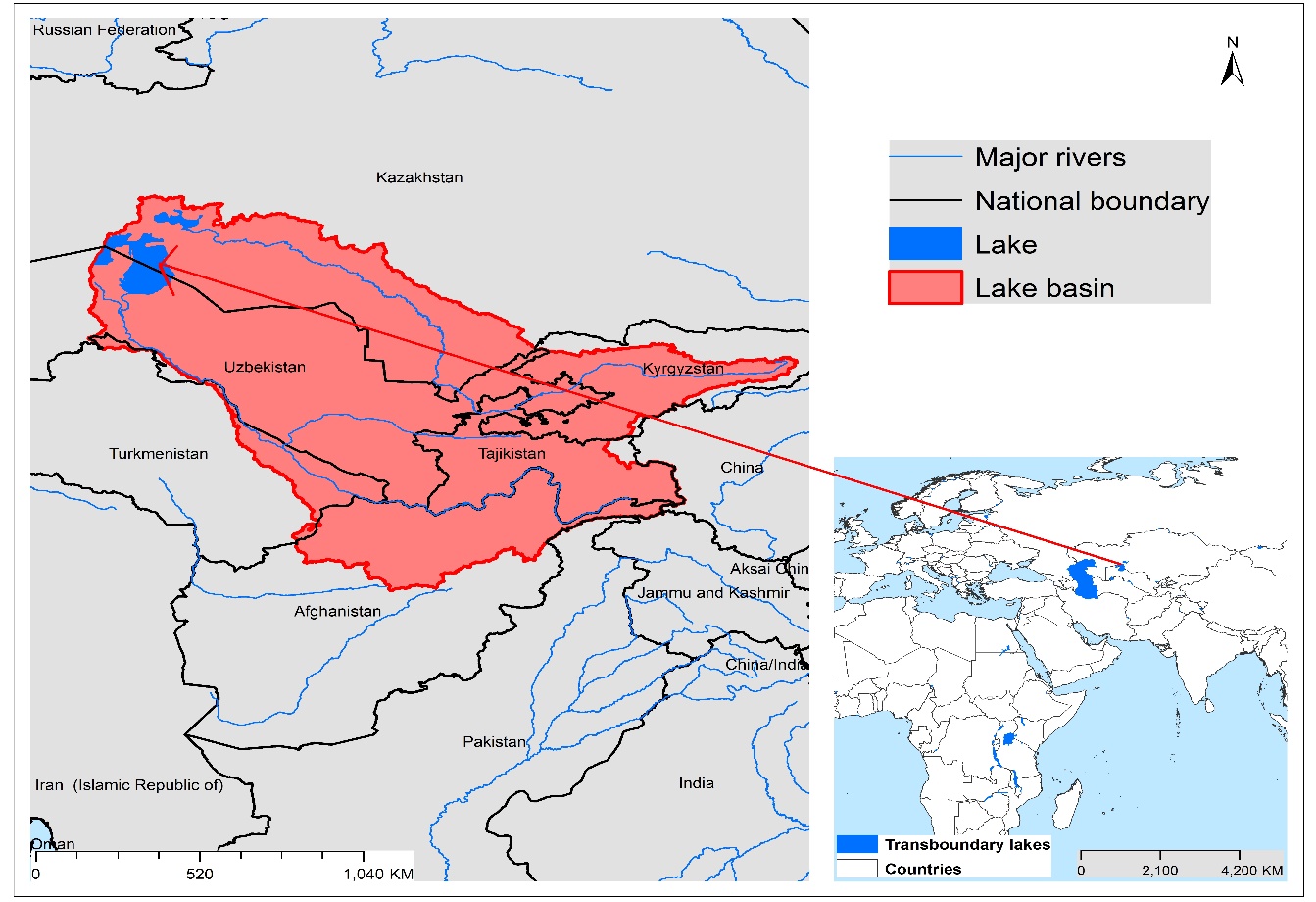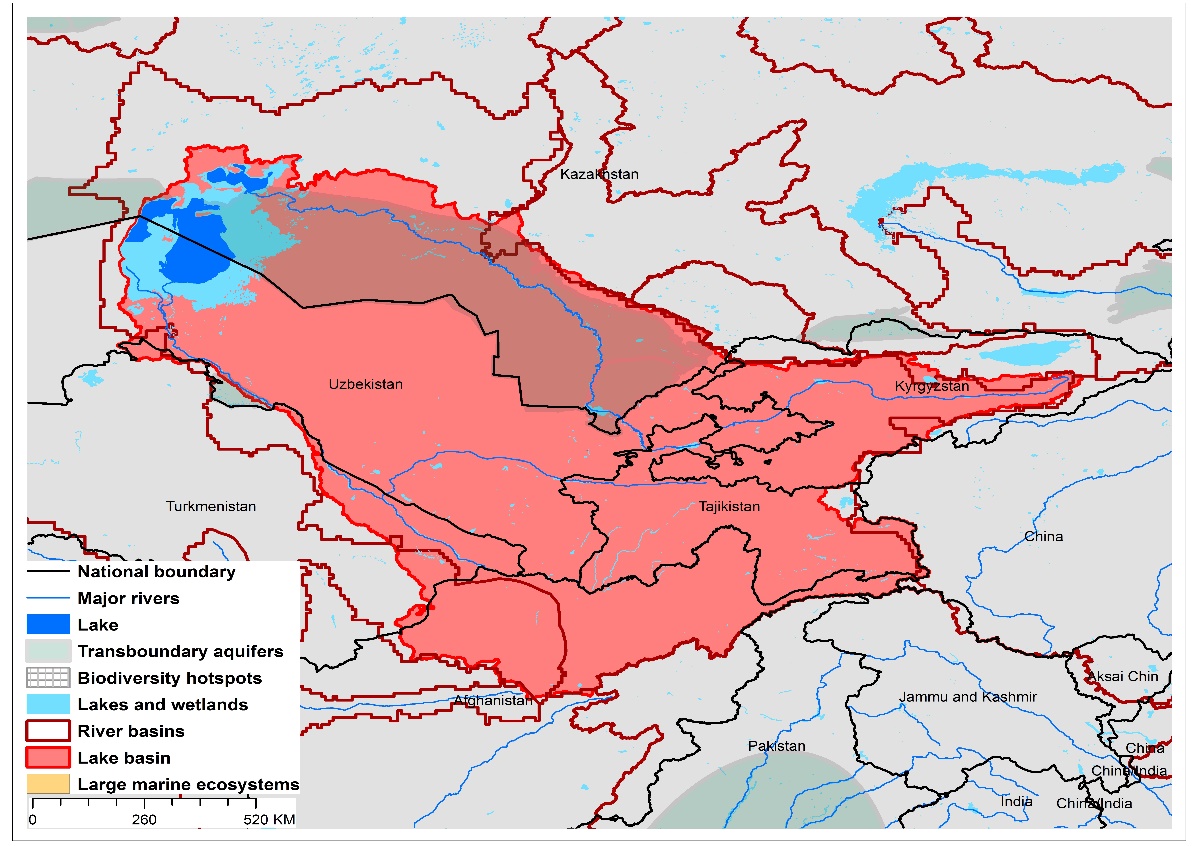The Aral Sea, a terminal lake and once one of the four largest lakes in the world, is a dramatic example of poor natural resource management, experiencing an extreme loss of water from poor policies and excessive agricultural irrigation practices beginning in the 1960s. Described as one of the world’s worst environmental disasters, its prosperous fishing industry was essentially destroyed, with resulting unemployment and economic hardships. The Aral Sea region is also heavily polluted. The lake declined to 10% of its original size, splitting into the north Aral Sea, eastern and western basins of the previously larger South Aral Sea, and a smaller lake between the North and South Aral Seas by 2007. The eastern basin completely dried up in 2014. Efforts are underway to replenish the North Aral Sea. Construction of a dam has improved the lake level, decreased water salinity, and facilitated a somewhat viable fishery. Although the lake has been the subject of a number of international water treaties, its future nevertheless remains unclear. It has already received GEF funding, but is again becoming a subject for possible GEF-catalyzed management interventions, which would require due elaboration within an appropriately-established international consultative process.

| TWAP Regional Designation | Eastern & Central Asia | Lake Basin Population (2010) | 48,540,276 | |
|---|---|---|---|---|
| River Basin | Aral (endorheic) | Lake Basin Population Density (2010; # km-2) |
30.5 | |
| Riparian Countries | Kazakhstan, Uzbekistan | Average Basin Precipitation (mm yr-1) |
309.4 | |
| Basin Area (km2) | 1,092,375 | Shoreline Length (km) | 1,784 | |
| Lake Area (km2) | 23,919 | Human Development Index (HDI) | 0.6 | |
| Lake Area:Lake Basin Ratio | 0.022 | International Treaties/Agreements Identifying Lake | Yes |
Aral Sea Basin Characteristics

(a)Aral Sea basin and associated transboundary water systems

(b)Aral Sea basin land use
A serious lack of global-scale uniform data on the TWAP transboundary in-lake conditions required their potential threat risks be estimated on the basis of the characteristics of their drainage basins, rather than in-lake conditions. Using basin characteristics to rank transboundary lake threats precludes consideration of the unique features that can buffer their in-lake responses to basin-derived disturbances, including an integrating nature for all inputs, long water retention times, and complex, non-linear response dynamics.
The lake threat ranks were calculated with a spreadsheet-based interactive scenario analysis program, incorporating data and information about the nature and magnitude of their basin-derived stresses, and their possible impacts on the sustainability of their ecosystem services. These descriptive data for Aral Sea and the other transboundary lakes included lake and basin areas, population numbers and densities, areal extent of basin stressors on the lake, data grid size, and other components considered important from the perspective of the user of the data results. The scenario analysis program also provides a means to define the appropriate context and preconditions for interpreting the ranking results.
The Aral Sea threat ranks are expressed in terms of the Adjusted Human Water Security (Adj-HWS) threats, Reverse Biodiversity (RvBD) threats, and the Human Development Index (HDI) score, as well as combinations of these indices. However, it is emphasized that, being based on specific characteristics and assumptions regarding Aral Sea and its basin characteristics, the calculated threat scores represent only one possible set of lake threat rankings. Defining the appropriate context and preconditions for interpreting the lake rankings remains an important responsibility of those using the threat ranking results, including lake managers and decision-makers.
(Estimated risks: red – highest; orange – moderately high; yellow – medium;
green – moderately low; blue – low)
| Adjusted Human Water Security (Adj-HWS) ThreatScore |
Relative Adj-HWS Threat Rank | Reverse Biodiversity (RvBD) Threat Score | Relative RvBD Threat Rank | Human Development Index (HDI) Score | Relative HDI Rank | ||
|---|---|---|---|---|---|---|---|
| 0.84 | 26 | 0.72 | 5 | 0.60 | 26 |
It is emphasized that the Aral Sea rankings above are discussed here within the context of the management and decision-making process, rather than as strict numerical ranks. Based on its geographic, population and socioeconomic assumptions used in the scenario analysis program, the calculated Adj-HWS score for Aral Sea indicates a medium threat rank compared to other priority transboundary lakes.
The Reverse Biodiversity (RvBD) for Aral Sea, which is meant to describe its biodiversity sensitivity to basin-derived degradation, places the lake in a high threat rank, compared to the other transboundary lakes. Management interventions directed to improving the biodiversity status must be viewed with caution, however, since we lack sufficient knowledge and experience to accurately predict the ultimate impacts of biodiversity manipulations and preservation efforts. Further, the RvBD scores indicate the relative sensitivity of a lake basin to human activities, and high threat scores per se do not necessarily justify management interventions. Such interventions may actually increase biodiversity degradation, noting that many developed countries have already fundamentally degraded their biodiversity because of economic development activities. Thus, activities undertaken to address the Adj-HWS threats may actually degrade the biodiversity status and resources, even if the health and socioeconomic conditions of the lake basin stakeholders are improved as a result of better conditions, thereby increasing stakeholder resource consumption.
The relative Human Development Index (HDI) places the Aral Sea basin in a medium threat rank in regard to its health, educational and economic conditions.
(Scores for Adj-HWS, RvBD and HDI ranks are presented in Table 1; the ranks may differ in some cases because of rounding of figures; Estimated risks: red – highest; orange – moderately high; yellow – medium;
green – moderately low; blue – low)
| Adj-HWS Rank | HDI Rank | RvBD Rank | Sum Adj-HWS + RvBD | Relative Threat Rank |
Sum Adj-HWS + HDI | Relative Threat Rank | Sum Adj-HWS + RvBD + HDI | Overall Threat Rank | |||
|---|---|---|---|---|---|---|---|---|---|---|---|
| 27 | 26 | 5 | 32 | 13 | 53 | 31 | 58 | 20 |
When multiple ranking criteria are considered together in the threat rank calculations, the Adj-HWS and HDI scores considered together place Aral Sea in the lower half of the threat ranks. The relative threat is notably increased when the Adj-HWS and RvBD threats are considered together. Considering all three ranking criteria together, Aral Sea exhibits a moderately high threat ranking.
Further, a series of parametric sensitivity analyses of the ranking results also was performed to determine the effects of changing the importance of specific criteria on the relative transboundary lake rankings. This analysis involved increasing or decreasing the weights applied to the threat ranks derived from multiple ranking criteria to reassess the relative impacts of the weight combinations on the threat ranks. For example, in determining the sensitivity of the Adjusted Human Water Security (Adj-HWS) and Biodiversity (BD) ranking criteria, the threat rank associated with the first was assumed to be of complete (100%) importance (i.e., rank weight of 1.0), while the other was assumed to be of no (0%) importance (i.e., rank weight of 0.0). The relative importance of the two ranking criteria was then successively changed, with weight combinations of 0.9 and 0.1, 0.8 and 0.2, etc., until the first ranking criteria (Adj-HWS) was assumed to be of no importance (rank weight of 0.0) and the second (BD) was of complete importance (rank weight of 1.0). In the case of Aral Sea, the 0.5 and 0.5 weight combinations for three cases of parametric analysis for Aral Sea resulted in respective threat rankings of 6th, 6th and 7th, respectively, among the total of 8 Asian transboundary lakes in the TWAP study (see Technical Report, Section 4.3.3, pp44-50).
In essence, therefore, identifying potential management intervention needs for Aral Sea must be considered on the basis of both educated judgement and accurate representations of its situation. A fundamental question to be addressed, therefore, is how can one decide that a given management intervention will produce the greatest benefit(s) for the greatest number of people in the Aral Sea basin? Accurate answers to such questions for Aral Sea, and other transboundary lakes, will require a case-by-case assessment approach that considers the specific lake situation and context, the anticipated improvements from specific management interventions, and its interactions with water systems to which the lake is linked.